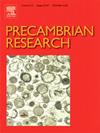南巴哈加域的流槽岩浆作用:对东亚马逊河克拉通和哥伦比亚组合地壳演化的启示
IF 3.2
2区 地球科学
Q2 GEOSCIENCES, MULTIDISCIPLINARY
引用次数: 0
摘要
碰撞造山作用是最复杂的地球动力学过程之一,它导致了多种花岗岩的形成,包括charnockites和强过铝花岗岩。这些环境中I-A和s型花岗岩的共存反映了地壳增厚和造山带的极端热条件。然而,对东亚马逊河克拉通流纹期岩浆活动的性质、时间和构造背景仍知之甚少。本研究通过整合在东亚马逊河克拉通古元古代碰撞造山带bacaj本文章由计算机程序翻译,如有差异,请以英文原文为准。
Rhyacian magmatism at the southern Bacajá Domain: implications for the crustal evolution of the SE Amazonian Craton and Columbia assembly
Collisional orogenesis represents one of the most complex geodynamic processes, leading to the formation of diverse granitoids, including charnockites and strongly peraluminous granites. The coexistence of I-A and S-type granites in these settings reflects crustal thickening and the extreme thermal conditions of orogenic belts. However, the nature, timing, and tectonic setting of the Rhyacian magmatism in the SE Amazonian Craton remain poorly understood. This study addresses this gap by integrating geological mapping, petrography, whole-rock geochemistry, U-Pb geochronology, and Nd-Hf isotopic studies conducted in the southern portion of the Bacajá Domain, a Paleoproterozoic collisional orogen in the SE Amazonian Craton. Our results identify previously unrecognized Rhyacian granitic and charnockitic rocks, formerly assigned to the Mesoarchean Cajazeiras Complex: (i) 2.12 Ga high-K calc-alkaline Bandeirante Granite (εHf(t) = -6.5 to -4.6, εNd(t) = -3.40); (ii) 2.10 Ga to 2.07 Ga calc-alkaline to high-K calc-alkaline Alto Rio Preto Granite (εHf(t) = -10.2 to -6.3, εNd(t) = -8.96 to -2.84); (iii) 2.09 Ga ferroan Maravilha Charnockite (εHf(t) = -9.2 to -8.2, εNd(t) = -3.01 to -1.91); (iv) 2.06 Ga magnesian Serra Azul Charnockite (εHf(t) = -8.8 to -5.8, εNd(t) = -6.41 to -4.71); and (v) 2.05 Ga strongly peraluminous Bernardino Granite (εNd(t) = -6.71). Overlapping ages suggest a prolonged magmatic activity (∼70 Ma). These rocks are mostly calc-alkaline and magnesian but vary to calcic or alkali-calcic and ferroan. Whole-rock geochemistry, zircon U–Pb–Hf, and whole-rock Nd isotopes point to a collisional origin for the magmatic rocks with extensive reworking of Archean sources and limited mantle contribution. We propose a two-stage geodynamic model: (1) collision between the Archean Bacajá basement and pre-collisional island arcs with the Carajás Province (∼2.12–2.10 Ga), leading to significant crustal thickening and the generation of small syn-collisional plutons; (2) the thickened crust becomes unstable, leading to crustal delamination and the generation of late- to post-collisional magmas (2.09–2.05 Ga). Compiled zircon U–Pb–Hf data reveals crustal reworking and juvenile input patterns similar to the Guiana Shield and West African Craton, supporting the hypothesis of their juxtaposition during the Columbia assembly.
求助全文
通过发布文献求助,成功后即可免费获取论文全文。
去求助
来源期刊

Precambrian Research
地学-地球科学综合
CiteScore
7.20
自引率
28.90%
发文量
325
审稿时长
12 months
期刊介绍:
Precambrian Research publishes studies on all aspects of the early stages of the composition, structure and evolution of the Earth and its planetary neighbours. With a focus on process-oriented and comparative studies, it covers, but is not restricted to, subjects such as:
(1) Chemical, biological, biochemical and cosmochemical evolution; the origin of life; the evolution of the oceans and atmosphere; the early fossil record; palaeobiology;
(2) Geochronology and isotope and elemental geochemistry;
(3) Precambrian mineral deposits;
(4) Geophysical aspects of the early Earth and Precambrian terrains;
(5) Nature, formation and evolution of the Precambrian lithosphere and mantle including magmatic, depositional, metamorphic and tectonic processes.
In addition, the editors particularly welcome integrated process-oriented studies that involve a combination of the above fields and comparative studies that demonstrate the effect of Precambrian evolution on Phanerozoic earth system processes.
Regional and localised studies of Precambrian phenomena are considered appropriate only when the detail and quality allow illustration of a wider process, or when significant gaps in basic knowledge of a particular area can be filled.
 求助内容:
求助内容: 应助结果提醒方式:
应助结果提醒方式:


